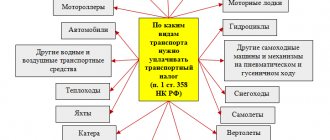UTII and motor transport services: conditions of application
Subp.
5 p. 2 art. 346.26 of the Tax Code of the Russian Federation allows the use of imputation when providing motor transport services for the transportation of passengers and goods in cases where the number of vehicles available to the taxpayer intended for transportation does not exceed 20 units. Vehicles may be in his possession, use, possession or disposal. Is it possible to apply UTII for cargo transportation if some of the cars are rented from individuals, find out here.
You will find explanations from the Federal Tax Service on how to calculate the maximum number of vehicles for UTII here.
An organization providing cargo and passenger transportation must register and pay tax at its location, an entrepreneur - at its place of residence (Clause 2 of Article 246.28 of the Tax Code of the Russian Federation). The same principle applies when transportation services are provided in another city or region.
ConsultantPlus experts explained what nuances to consider when registering as a UTII payer for the transportation of passengers or cargo. If you don't already have access to the system, get a free trial online.
The use of the UTII regime is possible only if it is permitted by regional legislation. Thus, first of all, it is necessary to familiarize yourself with the laws of the region in order to find out whether a specific type of activity falls under UTII in a given area or not.
Attention! Starting from 2021, UTII is planned to be abolished throughout the Russian Federation. A number of regions have already abandoned the special regime. Read more about the cancellation of UTII here.
When to report and pay transport tax
Do you want to easily pay and report taxes? Use the cloud service Kontur.Accounting! The service will remind you to pay taxes, carry out calculations and automatically generate a declaration. Get free access for 14 days
For organizations, the tax period is a calendar year, the reporting period is the first, second quarter and third quarter. The legislative bodies of the constituent entities of the Russian Federation may not establish reporting periods, but leave only annual reporting.
The deadlines for paying taxes and advance payments are also set by the regions. The deadline for paying the tax cannot be earlier than the deadline for filing the declaration, which is specified in paragraph 3 of Art. 363.1 of the Tax Code. Now it is February 1 of the year following the expired tax period.
Organizations submit a transport tax return to the tax authority at the location of the vehicles. The largest taxpayers submit declarations to the tax authority at the place of registration as the largest taxpayers.
Transport tax and advance payments are transferred to the budget at the location of the vehicles.
The location of the vehicle is recognized as:
- for water vehicles (except for small boats) - the place of state registration of the vehicle;
- for air vehicles - the location of the organization to which the vehicle is registered;
- for other vehicles - the location of the organization or its separate division under which the vehicle is registered.
Calculation of UTII: transport services (2020)
Let's consider the procedure for calculating the single tax on imputed income when providing services for the transportation of passengers and goods in 2021.
Read about the general procedure for calculating the tax base for the single tax on imputed income in this article.
1. At the first stage, the tax base is determined according to the formula given in Art. 346.29 Tax Code of the Russian Federation:
NB = BD × K1 × K2 × (FP1 + FP2 + FP3),
where: NB - tax base;
BD - basic profitability per month;
K1 is a deflator coefficient, the value of which is established annually by order of the Ministry of Economic Development;
K2 - correction factor, its value is established by local or municipal authorities;
Read more about coefficients K1 and K2 in the materials of the section “UTII Coefficients (K1, K2)”.
FP1, FP2, FP3 - values of the physical indicator in the 1st, 2nd and 3rd months of the quarter.
2. At the next stage, it is necessary to calculate the amount of single tax for the quarter using the formula:
UTII = NB × C,
where: NB - tax base;
C is the tax rate, according to Art. 346.31 of the Tax Code of the Russian Federation, for most regions it is equal to 15%, and the cities of Moscow, St. Petersburg and Sevastopol can now set it in the range from 7.5 to 15%.
It should be noted that when several types of activities are simultaneously conducted that fall under UTII, the above calculation of the single tax will be carried out for each type of activity (clause 2 of Article 346.29 of the Tax Code of the Russian Federation). The total amount of UTII for the tax period is derived by adding the results obtained.
3. At the last stage, the amount of tax to be paid to the budget is determined. To do this, the calculated tax amount must be reduced by the established percentage points. 2, 2.1 Art. 346.32 Tax deductions of the Russian Federation. These are:
- insurance contributions for social insurance (for compulsory health insurance, compulsory medical insurance, in case of temporary disability and in connection with maternity, against industrial accidents and occupational diseases);
This article talks about reducing UTII by the amount of mandatory insurance contributions..
- payment of temporary disability benefits to employees;
- payments under voluntary insurance contracts for employees in the event of their temporary disability (except for industrial accidents and occupational diseases).
These deductions can be applied by impostors who use the labor of hired workers. However, these deductions reduce the amount of tax by no more than 50% (paragraph 2, clause 2.1, article 346.32 of the Tax Code of the Russian Federation).
If an individual entrepreneur does not make payments to employees due to their absence, he has the right to reduce the tax by the amount of all fixed payments for compulsory health insurance and compulsory medical insurance (paragraph 3, clause 2.1, article 346.32 of the Tax Code of the Russian Federation). For individual entrepreneurs, such a reduction has no restrictions on the amount, i.e., the imputed tax can be reduced to zero.
Check whether you have correctly determined the amount of tax for transport services with the help of advice from ConsultantPlus. Get trial access to the system and proceed to the calculation example for free.
Attention! To simplify your tax calculation, use our UTII calculator. The calculator itself is here. And here you will read about how to use it correctly.
How can an individual entrepreneur provide transport services?
The end of the year is approaching, the time to sum up the results of activities, submit reports and pay taxes and contributions.
As a taxation system with an object - the provision of transport services, most individual entrepreneurs usually choose UTII. If an entrepreneur is just planning to start his business, then he needs to decide on the choice of system before submitting documents. However, if the documents have been submitted, but the taxation is not satisfactory, you can switch to UTII within 5 years from the date of registration of the taxpayer. The use of special equipment (cranes, dump trucks, loaders, bulldozers, etc.) cannot be subject to a single tax according to the letter of the Ministry of Finance dated May 25, 2005.
Transport does not have to be owned by the individual entrepreneur; it can be a rental or leasing agreement. An important condition: the number of cars used in business activities should not exceed 20 pieces, otherwise it will be necessary to switch to another system in UTII: USNO or OSNO. A limit is also imposed on the number of employees - no more than 100 people.
On UTII, the entrepreneur is required to calculate and pay the following taxes and contributions:
- single tax on imputed income;
- contributions to the pension fund, health insurance fund, both for oneself and for hired employees, if any.
Note that UTII itself refers to quarterly payments and reports on it must be submitted quarterly, but it is calculated monthly. For the object “provision of transport services,” the physical indicator is the number of vehicles involved in the activity. The size of the basic profitability depends on what transport services are provided:
- passenger transport services – 1500 rubles/unit;
- cargo transportation services – 6,000 rubles/unit.
Consider example 1: an individual entrepreneur has a fleet of 5 cars. All of them are involved in the provision of passenger transportation services. The calculated tax amount will be:
CH=(1500*5*1.672*K2)*0.15*3=calculated amount
Where:
CH – tax amount,
1.672 – K1, the size of which is regulated at the federal level,
K2 – regional coefficient. The current value can be found on the website of the tax service of your region,
0.15 – interest rate,
3 – number of months for which payment will be made.
If during the quarter, the size of the physical indicator changed, for example: one vehicle was sold in the first month and two were purchased in the last month of the quarter, then the calculation must be carried out separately for each period, adding up the resulting amounts.
The calculated amount of the single tax can be reduced:
- If an individual entrepreneur calculates and pays contributions to funds for employees, then the tax can be reduced within 50%. This category also includes benefits for temporary disability, pregnancy and childbirth;
- If an individual entrepreneur pays contributions only for himself, then the calculated amount can be reduced by 100% of the contributions paid.
Let's consider example 2: An entrepreneur is engaged in cargo transportation and has a fleet of 7 cars. Then the calculation occurs according to the following scheme:
CH = (6000*7*1.672*K2)*0.15*3 = calculated amount.
It is also subject to reduction by the amount of contributions.
The size of the fixed payment to the Pension Fund for an entrepreneur will be 17,328.48 rubles. – contribution to the pension fund, 3399.05 – contribution to the health insurance fund. These amounts can be paid in a lump sum no later than 12/31/2014 or paid quarterly.
Total: 1 ( 5.00 out of 5)
Calculation of UTII: basic profitability for transport services
In Art. 346.29 of the Tax Code of the Russian Federation defines basic profitability and provides its values for all types of activities falling under UTII.
So, basic profitability is a conditional income in rubles that can be obtained in 1 month from 1 physical indicator. The physical indicator, in turn, characterizes a specific type of activity in various comparable conditions. Both of these indicators are used to calculate UTII.
Thus, when calculating UTII for transport services for the transportation of passengers, the basic profitability is 1,500 rubles. for one seat. The seat in this case will be a physical indicator.
How to determine the number of seats for calculating UTII, read the ready-made solution ConsultantPlus.
When providing cargo transportation services, the basic profitability is 6,000 rubles. from each vehicle - a physical indicator for this type of activity.
If the imputed person provides services for repair, maintenance and washing of vehicles, then when calculating the tax, he needs to use the value of the basic profitability equal to 12,000 rubles. per person, for everyone involved in this activity, including the individual entrepreneur himself.
Find the full base yield table here.
Generally established taxation system
Entrepreneurs with a significant fleet of vehicles, a number of staff and service personnel can apply the OSN.
Positive aspects of using this type of accounting for individual entrepreneurs:
- There are no restrictions on the number of vehicles or the volume of revenue.
- Possibility to provide services for organizations or individual entrepreneurs using special taxation system with VAT payment. The absence of restrictions on standards for freight transportation services is often used by enterprises to reduce the tax burden.
Negative aspects of maintaining OSN:
- The need to prepare a significant number of supporting documents to confirm expenses.
- Obligation to pay VAT. There are no significant revenue turnover when providing cargo transportation services. If an individual entrepreneur is not interested in working with companies that have VAT obligations, the entrepreneur can refuse to pay VAT.
You must submit an application for exemption to the Federal Tax Service, after approval of which you will not be required to pay VAT. Eligibility is confirmed annually.
In the absence of significant expenses (for example, when using leased vehicles), the use of the general system can lead to significant tax liabilities. What and how much taxes to pay can be determined at the stage of choosing an accounting form.
UTII regime for vehicle repair, maintenance and washing
Subp. 3 p. 2 art. 346.26 of the Tax Code of the Russian Federation classifies the provision of services for repair, maintenance and washing of motor vehicles as falling under UTII. These services for the purposes of applying UTII in accordance with paragraph. 9 tbsp. 346.27 of the Tax Code of the Russian Federation include:
- Services provided for a fee to individuals and legal entities - code 45.2 according to OKVED 2 OK 029-2014 (NACE rev. 2), approved. by order of Rosstandart dated January 31, 2014 No. 14-st).
- Services, also provided for a fee, for technical inspection of vehicles for the purpose of their admission to participation in road traffic (mandatory state technical inspection) - code 71.20.5 according to OKVED 2.
It is impossible to apply UTII in accordance with paragraph. 9 tbsp. 346.27 of the Tax Code of the Russian Federation when providing services:
- for refueling vehicles;
- warranty repairs and maintenance;
- storage of vehicles in paid and impounded parking lots.
But the Ministry of Finance and the courts are still arguing about the possibility of using UTII when renting out a vehicle with a crew. In what cases judges and officials allow the use of a special regime, find out from the Tax Guide. To do this, get trial access to ConsultantPlus for free.
Imputed income
Individual entrepreneurs often use UTII when providing cargo transportation services. The form is characterized by the absence of the need to maintain complete document flow.
Advantages of using UTII:
- The obligation to take into account only the physical indicator – the number of vehicles. The individual entrepreneur maintains only general documents without taking into account fuel costs, spare parts and other freight transportation costs.
- Possibility of combining the system with another type of taxation. It is justified to combine only the simplified tax system with the “income” scheme, in which there is no need to take into account costs. Forms that complement each other make it possible to create conditions under which it is possible to legally eliminate accounting and pay less to the budget.
Disadvantages of using UTII:
- The need to pay a single tax regardless of the sale of services.
- There is a limit on the number of cars. It is allowed to use up to 20 units of vehicles.
If there is a small fleet of vehicles and contracts of insignificant value, an individual entrepreneur can choose between UTII and PNS. For comparison, you need to obtain information from the Federal Tax Service about the cost of a patent for cargo transportation and compare it with the tax on imputed income.
Attention! The patent system applies only in the region of its acquisition. When concluding contracts for the provision of transport services, it is necessary to ensure that the place where the agreement is drawn up and the place where the patent is applied coincides.
Results
So, in 2021 UTII applies to services for the transportation of passengers and cargo, as well as technical inspection services. When switching to a special regime for motor transport services, you need to take into account local legislation and the number of vehicles, as well as know the value of the physical indicator for the corresponding type of activity.
Sources: Tax Code of the Russian Federation
You can find more complete information on the topic in ConsultantPlus. Free trial access to the system for 2 days.









